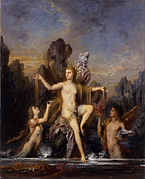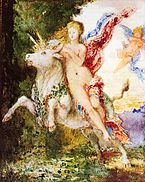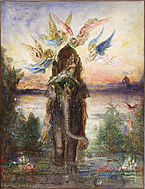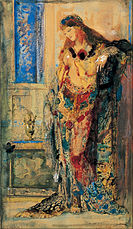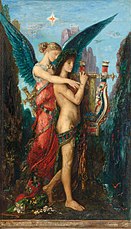Gustave Moreau
This article needs additional citations for verification. (June 2014) |
Gustave Moreau | |
|---|---|
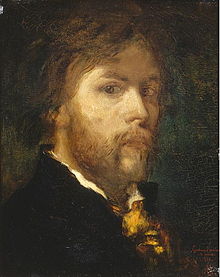 Self-portrait of Gustave Moreau, 1850 | |
| Born | 6 April 1826 |
| Died | 18 April 1898 (aged 72) Paris |
| Nationality | French |
| Education | François-Édouard Picot |
| Known for | Painting |
| Movement | Symbolism |
Gustave Moreau (French: [mɔʁo]; 6 April 1826 – 18 April 1898) was a major figure in French Symbolist painting whose main emphasis was the illustration of biblical and mythological figures. As a painter, Moreau appealed to the imaginations of some Symbolist writers and artists.
Biography
Moreau was born in Paris. His father, Louis Jean Marie Moreau, was an architect, who recognized his talent. His mother was Adele Pauline des Moutiers. Moreau initially studied under the guidance of François-Édouard Picot and became a friend of Théodore Chassériau, whose work strongly influenced his own. Moreau had a 25-year personal relationship, possibly romantic, with Adelaide-Alexandrine Dureux (b.Guise, 8 November 1835), a woman whom he drew several times.[1] His first painting was a Pietà which is now located in the cathedral at Angoulême. He showed A Scene from the Song of Songs and The Death of Darius in the Salon of 1853. In 1853 he contributed Athenians with the Minotaur and Moses Putting Off his Sandals within Sight of the Promised Land to the Great Exhibition.[2]
Oedipus and the Sphinx, one of his first symbolist paintings, was exhibited at the Salon of 1864. Moreau quickly gained a reputation for eccentricity. One commentator said Moreau's work was "like a pastiche of Mantegna created by a German student who relaxes from his painting by reading Schopenhauer".[3] The painting currently resides in the permanent collection at the New York Metropolitan Museum of Art.[4]
On March 28 1890 Alexandrine Dureux died and her death affected Moreau greatly, his work after this point contains a more melancholic edge. She was buried at the same cemetery that Moreau himself would be laid to rest (see below).
Moreau became a professor at Paris' École des Beaux-Arts in October 1891 and among his many students were fauvist painters Henri Matisse and Georges Rouault. Jules Flandrin, Theodor Pallady and Léon Printemps also studied with Moreau.
Moreau died of stomach cancer and was buried at the Cimetière de Montmartre in Paris in his parents tomb.
During his lifetime, Moreau produced more than 8,000 paintings, watercolors and drawings, many of which are on display in Paris' Musée national Gustave Moreau at 14 rue de la Rochefoucauld (9th arrondissement). The museum is in his former workshop, and began operation in 1903. André Breton famously used to "haunt" the museum and regarded Moreau as a precursor of Surrealism. His work influenced the next generation of Symbolists, particularly Odilon Redon and Jean Delville, a leading figure in Belgian Symbolism in the early part of the twentieth century.
Gallery
- Gustave Moreau's works
-
Oedipus and the Sphinx (1864)
-
Jason and Medea (1865)
-
Orpheus (1865)
-
Venus Rising from the Sea (1866)
-
Europa and the Bull (1869)
-
La chimère (1876)
-
Salomé (1876)
-
The Apparition (1876)
-
Jacob and the Angel (1878)
-
Galatée (1880)
-
The Sacred Elephant (Péri) (1885)
-
Eve by Gustave Moreau (1885)
-
The Toilette (1885-90)
-
Song of Songs (Cantique des Cantiques) (1893)
-
Jupiter and Semele (1894-95)
See also
References
- ^ Kaplan, Julius (1974). Gustave Moreau. Little Brown & Company. pp. 7, 55. ISBN 0-8212-0628-1.
- ^ "Artchive Gustave Moreau". www.artchive.com. Retrieved October 2014.
{{cite web}}: Check date values in:|accessdate=(help) - ^ Lucie-Smith, Edward. (1972) Symbolist Art. London: Thames & Hudson, p. 63. ISBN 0500201250
- ^ Winkfield, Trevor (April 2012). "A Letter to Bryan Osburn from Trevor Winkfield". The Brooklyn Rail.




